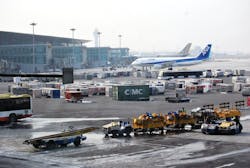Focus And Standards Can Prevent Ramp Accidents
There are times when we are doing everything right. Crossing in the crosswalk, for example – with the light. We should be able to let our guard down knowing we are safe. But accidents can still happen. Life can find a way to turn things upside down when we least expect it.
And so it is with ground handling. We work in what can be an unforgiving environment each day. Engine exhaust, heavy equipment, and flammable fuels can pose more risks than we can count. The old cliché "out of sight out of mind" proves most dangerous since it breeds complacency. The more comfortable we become with the danger, the easier and further from our focus it drifts, and the easier it can be to fall into it.
The first step, then, to take to mitigate these risks is awareness.
Once the plane lands, and after the engines stop whining, there are areas of risk that require situational awareness at all times. They include marshalling and parking; safety and security of the passengers; servicing the aircraft; aircraft security and fueling.
Some pertinent questions to be considered may be:
- Who is handling the plane?
- Are they properly trained and staffed?
- Do they have the proper type and size of equipment for the task to be accomplished?
- What is the safety culture like?
- Does it tolerate work-arounds and shortcuts?
In comparison to an aircraft crash it may sound like small potatoes, but direct costs associated with aircraft damage on the apron and in maintenance facilities are upwards of $1.2 billion a year. Factoring in the indirect costs of the aircraft being out of service, increased insurance premiums, temporary replacement, injuries, and other associated expenses, that number can approach $5 billion.
But remaining keenly aware of the potential danger in our everyday workplace takes more than just focus. The sad reality is that much of it is preventable with training and standardization of best practices.
TRAINING
The most significant risk factors for ground damage occur in towing, ramp movements, ground service equipment and hangar movements, which include maintenance facilities and operations.
One common thread running through all of these risk areas is a lack of training. As a manager, the training of employees is paramount to a safe operation. Once training is completed, however, and the employee has demonstrated proficiency at the task, the employee should incorporate a self-assessment as part of every task.
Self-assessment is an excellent tool for determining if standards have been met to accomplish a task. You can easily self-assess by asking yourself the following:
- Am I properly trained to perform the task?
- Am I adequately equipped to perform the task?
- Are the tools or equipment I am about to use in good working order?
- Do I need assistance to perform the task?
- Do I have the appropriate personal protective equipment to keep myself safe?
BEST PRACTICES
There are some basic best practices that go a long way in reducing ground accidents and incidents, the foundation of which is to never ask anyone to do a job or task they have not been trained to do. So keep an open door to questions. Be approachable. Teach others to stop if they are unsure, and embrace a request for assistance. Safety procedures such as the chocking of the main gear at all ramp parking situations or while the aircraft is in maintenance sounds a bit elementary, but this is an area that is subject to being ignored, especially if the aircraft will not be parked for an extended period of time.
Let’s take a look at one routine: moving aircraft.
- A ground marshaller should be used as aircraft arrive and depart from parking spots. Wing walkers are especially helpful when pulling or backing an aircraft into or out of a hangar.
- An industry best practice tells us that we need two plus a tug driver when maneuvering the aircraft on the ramp or removing it from a hangar, and three plus a tug driver when pushing an aircraft into a hangar or tight parking location.
- The use of warning cones at wing tips and tail to avoid wing overlap hazards are considered preventative best practices.
- Confirm with the pilot that the brakes are off before beginning to tow the airplane. A trained person in the cockpit as a brake monitor for heavy aircraft is recommended.
- If you are not familiar with the aircraft type, and have not been properly trained, do not attempt to move the aircraft, leave the aircraft where it is and seek out someone who is familiar before towing.
All of the above can be culminated in an integrated and comprehensive safety program for the entire organization.
It may not be possible to eliminate all risk as it is inherent in what we do, and the tools and equipment we use to do it, but documenting procedures establishes expectations and sets standards for operational behavior. Furthermore it provides a framework with which to measure accountability and strive for continued improvement.
Remaining safe on the ground is everyone’s responsibility.
About the author: DeborahAnn Cavalcante leads Diversified Aviation Consulting (DAC) and along with her associates has firsthand experience in air carrier operations, private charter aircraft, general aviation operations, military/civilian interface, FBO management, maintenance repair station training, safety training, human factors training, and customer service training. For more information on DAC visit www.dac.aero.





